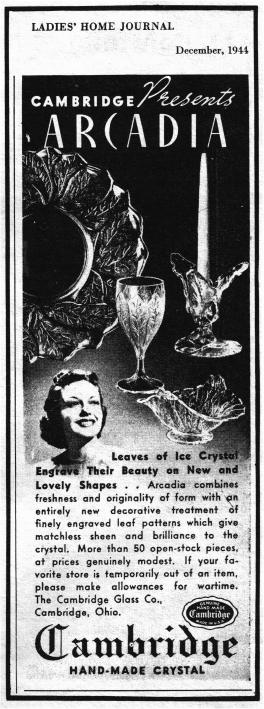National Depression Glass Association
Preserving America's Glass Manufacturing Heritage
Cambridge's Arcadia
by Phyllis Smith
Glass Review - May 1982
 The question has been asked many times "Just what is the difference
between the Everglade and Arcadia patterns?" and the answer has to be
"Very little, if any difference exists!"
The question has been asked many times "Just what is the difference
between the Everglade and Arcadia patterns?" and the answer has to be
"Very little, if any difference exists!"
As can be seen in this advertisement which appeared in the December, 1944 editions of the Ladies Home Journal, Better Homes & Gardens, and several other popular magazines of that era, the Cambridge Glass Company presented the ARCADIA pattern as "leaves of Ice Crystal on new and lovely shapes". In the May 1943 issue of House & Garden they introduced "The New ARCADIA" and described it as "the latest expression of America's supremacy in glassmaking ..."
The addition to this "new" Arcadia line of such items as a cocktail, wine, 12 oz. footed ice tea, 5 oz. footed tumbler or claret, ice pail w/handle, relish plates, bonbon's, candy box w/cover, mayonnaise sets, and many other items made it seem as though they had indeed come out with a brand new line. But in reality, it was just the old Leaf or Everglade pattern, with a new and updated look!
The NCC 1930-34 Catalog Reprint, pages 33-25 & 26, pretty well proves the above statement in as much as these pages contain pictures of the plate and candlestick as shown to be "new" in the 1944 advertisement.
The advertising information we have found regarding this ARCADE line indicates that it was produced in crystal only. Of course there are always exceptions to every statement we make (or so it seems) and the exception here is in the fact that the candy box w/cover has been found in the Cambridge Violet color. There may be other exceptions, but we have not heard of them as yet! This is not a particularly easy pattern to collect, but there is enough of it around to make it well worth your effort.
It should be noted that the Imperial Glass Company did reproduce several of these ARCADIA and EVERGLADE items for a short period of time. Our research is not complete enough at this time to list the various items and the colors in which they were produced.